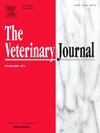Clinical, laboratory, and ultrasonographic insights into Platynosomum fastosum infection in domestic cats: Diagnostic challenges and hepatobiliary implications
IF 3.1
2区 农林科学
Q1 VETERINARY SCIENCES
引用次数: 0
Abstract
Platynosomiasis is a hepatobiliary disease that primarily affects cats, caused by the trematode Platynosomum fastosum. In this context, this study aims to describe the main clinical, laboratory, and ultrasonographic findings of domestic cats naturally infected by P. fastosum. Six cats treated at the Veterinary Teaching Hospital (HV) of São Paulo State University (UNESP) in Botucatu, São Paulo, Brazil, with a coproparasitological diagnosis positive for P. fastosum were selected for this study. The following parameters were analyzed: clinical signs, complete blood count, serum biochemistry, and ultrasonographic changes. Clinical signs observed included jaundice, apathy, dehydration, and gastrointestinal symptoms such as emesis and constipation. Hematological analyses revealed normal ranges for most variables, except evidence of monocytosis. One cat exhibited leucocytosis associated with neutrophilia, eosinophilia, and monocytosis. Biochemical profiles indicated significantly high liver enzymes levels: alanine transaminase (mean 331 ± 305.3 UI/L), aspartate transaminase (mean 181.8 ± 98.9 UI/L), alkaline phosphatase (mean 260.8 ± 270.4 UI/L), and gamma-glutamyl transferase (mean 14.98 ± 11.52 UI/L). Ultrasonographic findings included hepatomegaly, gallbladder wall thickening, bile duct dilation, and increased pancreatic dimensions with reduced echogenicity, indicating possible cholangitis and pancreatitis, respectively. The elevated liver enzyme levels, clinical signs of jaundice, and ultrasonographic abnormalities are consistent with liver damage and potential cholangitis and pancreatitis due to Platynosomum fastosum infection. These findings highlight the need for targeted diagnostics that should support therapeutic interventions for felines suffering from platynosomiasis.
临床,实验室和超声观察家猫的快速白腹虫感染:诊断挑战和肝胆意义。
白腹虫病是一种主要影响猫的肝胆疾病,由吸虫白腹虫引起。在此背景下,本研究旨在描述家猫自然感染快速棘球绦虫的主要临床、实验室和超声检查结果。在巴西圣保罗州立大学(UNESP)兽医教学医院(HV)治疗的6只猫被选择用于本研究,这些猫的共寄生虫学诊断为fastosum阳性。分析以下参数:临床体征、全血细胞计数、血清生化、超声检查变化。临床症状包括黄疸、精神淡漠、脱水、呕吐、便秘等胃肠道症状。血液学分析显示,除了单核细胞增多症外,大多数变量的范围正常。一只猫表现出与嗜中性粒细胞增多、嗜酸性粒细胞增多和单核细胞增多有关的白细胞增多症。生化指标显示肝酶水平显著升高:丙氨酸转氨酶(平均331±305.3 UI/L)、天冬氨酸转氨酶(平均181.8±98.9 UI/L)、碱性磷酸酶(平均260.8±270.4 UI/L)、γ -谷氨酰转移酶(平均14.98±11.52 UI/L)。超声检查结果包括肝肿大,胆囊壁增厚,胆管扩张,胰腺尺寸增大,回声减弱,分别提示胆管炎和胰腺炎。肝酶水平升高、黄疸的临床体征、超声检查异常与快速白锥虫感染引起的肝损害及潜在的胆管炎和胰腺炎相一致。这些发现强调了有针对性的诊断的必要性,这些诊断应该支持对患有扁桃病的猫科动物进行治疗干预。
本文章由计算机程序翻译,如有差异,请以英文原文为准。
求助全文
约1分钟内获得全文
求助全文
来源期刊

Veterinary journal
农林科学-兽医学
CiteScore
4.10
自引率
4.50%
发文量
79
审稿时长
40 days
期刊介绍:
The Veterinary Journal (established 1875) publishes worldwide contributions on all aspects of veterinary science and its related subjects. It provides regular book reviews and a short communications section. The journal regularly commissions topical reviews and commentaries on features of major importance. Research areas include infectious diseases, applied biochemistry, parasitology, endocrinology, microbiology, immunology, pathology, pharmacology, physiology, molecular biology, immunogenetics, surgery, ophthalmology, dermatology and oncology.
 求助内容:
求助内容: 应助结果提醒方式:
应助结果提醒方式:


